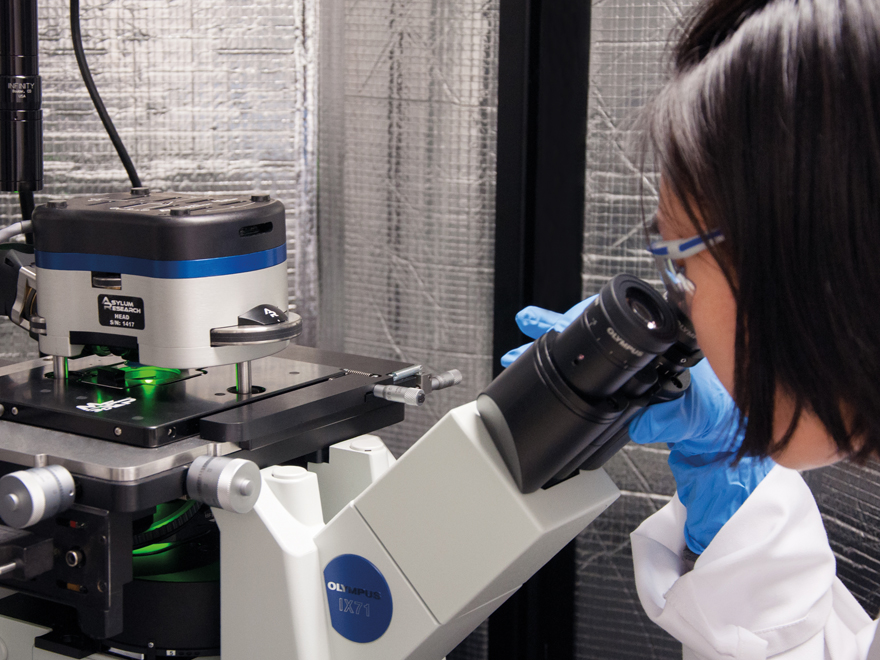In a wide variety of biomedical applications, fluorescence signals are used to detect several analytes such as biomolecules. For example, detection in PCR analysis of (corona) viruses is based on fluorescent dyes. Improving such methods is crucial to increase the sensitivity of biosensing and accelerate detection.
In order to reduce background signals during detection, we use dyes that emit light in the near-infrared range. The near-infrared is a region of the electromagnetic spectrum that is not visible to humans, with wavelengths between 800nm and 1700nm. Due to the reduced autofluorescence, as well as the reduced amount of scattering and absorption in biological samples light in this region has the property of being able to penetrate deeper into biological tissue. Thus, it is also referred to as the "tissue transparency window" (650-1350nm).
However, the number of nanomaterials that fluoresce in the near-infrared and are used for signal transmission is limited. Besides colloidal dyes or organic fluorophores, carbon nanotubes stand out with their unique properties. Besides them being extremely photostable, they exhibit additional sensing capabilities such as unusually high local sensitivity to their environment.
The carbon-based nanosensors developed at Fraunhofer IMS are ideally suited for imaging analytes. Based on the change in their fluorescence response, said analytes can be detected with high time and spatial resolution. The biological transparency and high signal-to-noise ratio of the light they emit is not only useful for measurements on biological samples, but also promising for in vivo applications such as the use of nanosensors for sterile monitoring in implants.
To study the nanomaterials and biomolecules on their surface, we use methods of spectroscopy and microscopy for the near infrared. We use near-infrared spectroscopy for process control in the preparation and biofunctionalization of fluorescent nanomaterials.
A type of chemical imaging can be achieved using arrays of near-infrared fluorescent nanosenors with microscope systems optimized for this wavelength range. This allows both spatially and temporally resolved information of a sample to be obtained, such as dynamic and high-resolution imaging of the release of neurotransmitters from cells. (High-resolution imaging of cellular dopamine efflux using a fluorescent nanosensor array | PNAS Imaging of Monoamine Neurotransmitters with Fluorescent Nanoscale Sensors - Dinarvand - 2020 - ChemPlusChem - Wiley Online Library).
We use high-resolution imaging with InGaAs detectors for non-contact differential diagnostics, such as distinguishing between different bacterial strains. (https://www.nature.com/articles/s41467-020-19718-5).
Furthermore, we are also exploring new nanomaterials that can increase the signal-to-noise ratio by detecting fluorescence lifetime instead of fluorescence intensity. Most known dyes that fluoresce in the near-infrared have very short lifetimes (picoseconds) that are difficult to measure. Conversely, dyes with technically measurable lifetimes (nanoseconds) typically do not fluoresce in the near infrared.
We are; therefore, also investigating a new class of 2D nanomaterials with much longer fluorescence lifetimes in the microsecond range, which can be detected with CMOS-based single-photon avalanche diodes (SPADs), among others. The Fraunhofer IMS has a renowned expertise in the field of these optical detectors and integrated sensor system solutions.
The SPAD arrays have the world's lowest dark count rate, so that a very good signal-to-noise ratio is achieved. This is an essential requirement for optical biosensor applications. In combination with our highly sensitive fluorescent biosensors based on functionalized nanomaterials, optical responses can thus be detected and processed without signal loss and complex optics. This allows the sensor systems to become significantly more compact and cost-effective compared to existing laboratory systems, making them a promising technology for the next generation of medical diagnostics.
